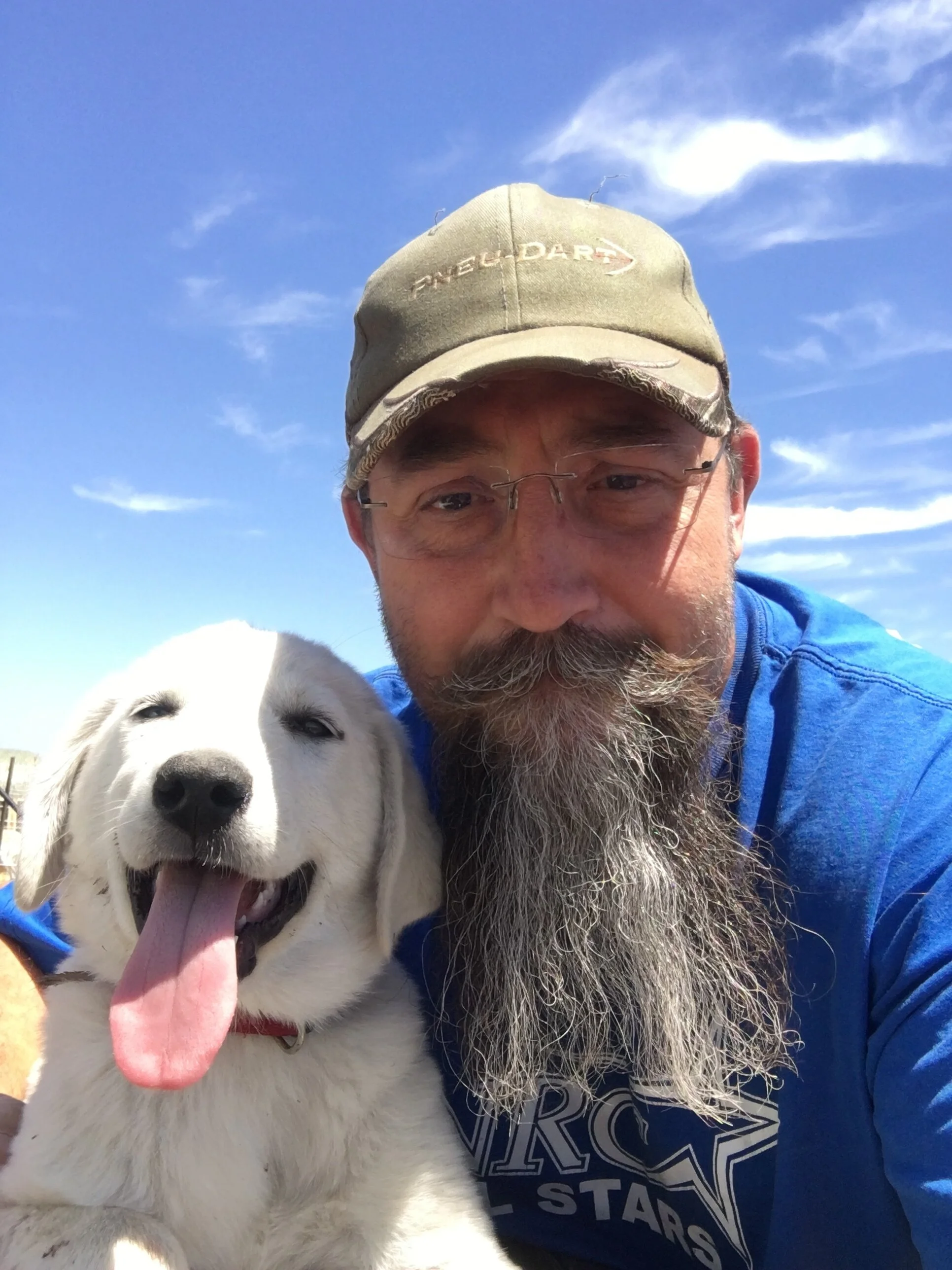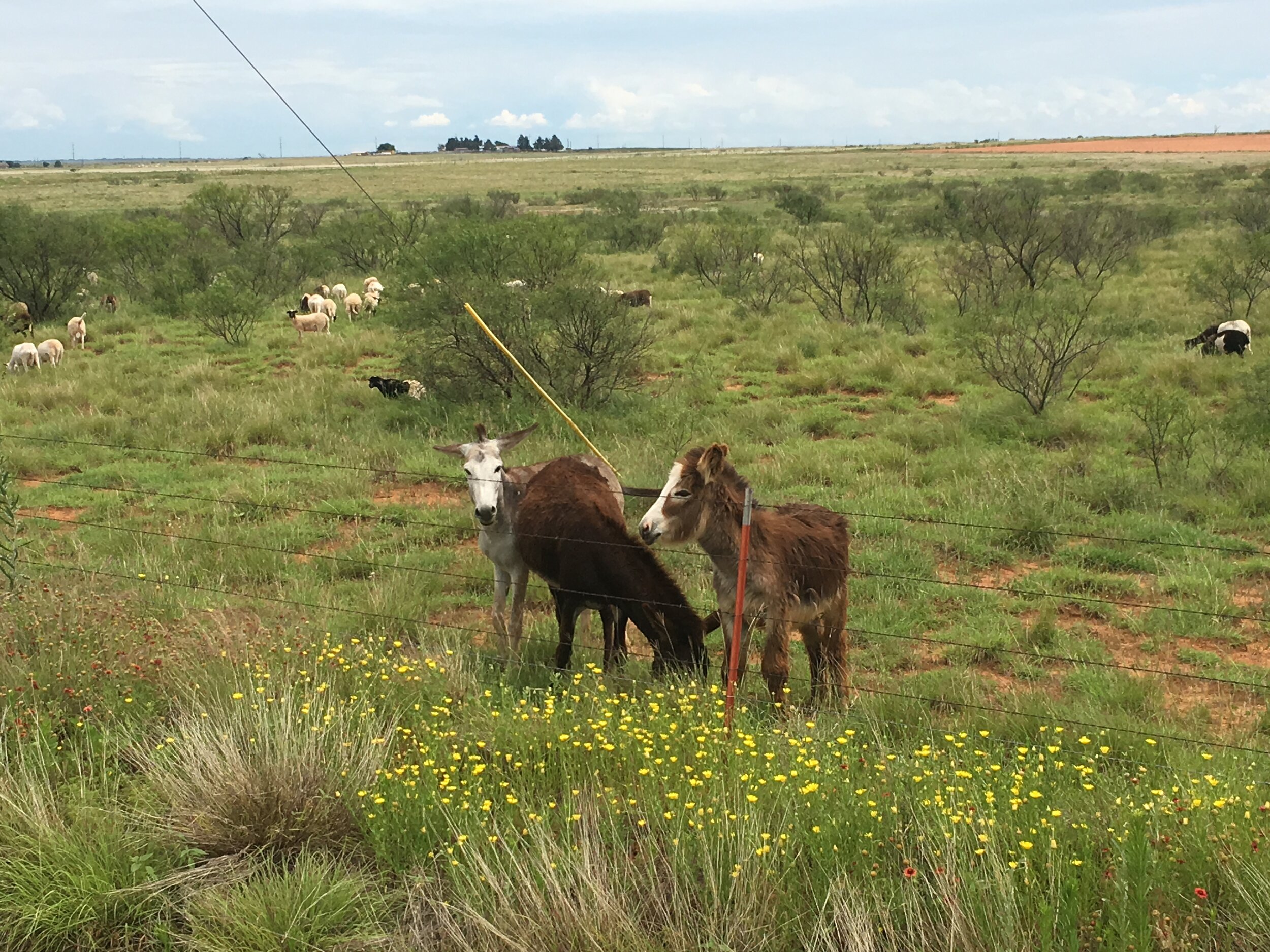Protectors – Meet the animals that protect our other animals.
Clover Brown and me
Have you ever wondered about who watches over the animals when we are not doing it? Who stays up all night patrolling the parameter around and amongst the animals making sure that ole Wylie Cayote doesn’t sneak in and take a chicken or a lamb! Shoot every meat-eating varmint (racoon, bobcats, opossum & skunks) wants to feast on a sleeping chickens and coyotes and bobcats both are hard on unattended lambs. These guys are super patient and will make sure the prey is isolated or until it is super dark before they strike …and this is a never ending 365 days & nights a year …so what is a farmer to do? Well we deploy protector animals that have great eyes for seeing day or night, great noses to test the wind along with great ears to hear all those that encroach…not to mention the tools to enforce their will should the perpetrator be caught in their attempted malice!! …and these guys mean business!
Our guardians of choice are dogs and donkeys. Now I describe them above as to what they do but I’m also going to let you know how they do it… the tactics they use and how by using both with our sheep (only dogs with the chickens) we multiply what one can do alone substantially.
Dogs – Great Pyrenees / Anatolian crossbreed & Akbash
Dogs Watching me watch the sheep
Out of the edge of the tall grass the coyote stepped… eyeing the chickens gathered around the coop-trailer late one evening. He was being sneaky like any coyote worth his salt would be, coming in downwind hoping to identify any unseen threat. Feeling confident that the coast was clear he started his low crawl to get in closer to the chickens… waiting, hoping that one would venture out close to him so he could grab it and run back to the grass and high-tail it away as fast as he could chicken in hand …mouth! That is what he did lots of times… he had been coming here for weeks and had been successful many times and he was confident that he would be again tonight. What this young coyote didn’t realize is that the dogs were aware of his antics and they were setup to catch him in the act if he gave them the chance. These three dogs are Great Pyrenees/Anatolian mixed and both breeds are guardians …they have been raised around the chickens and cattle but a little too close to the house so they are as much farm guardians as they are livestock guardians and like to work at day around the house lounging in the shade and at night around the chickens. Tonight, they were on point with the chickens a little earlier than normal or maybe the coyote was a little later than usual but today their paths would cross! As ole Wylie continued his stalk to steal another chicken the dogs saw him and moved on him quickly Wylie headed for the grass with dogs in hot pursuit …right before they get to the grass one dog catches Wylie and grabs ahold of him …think big white sharp teeth! As she grabs him he fights back but can’t gain his freedom… the other sister and mother dog arrive on the scene and they each grab a corner of ole Wylie and they all begin to bite and pull him in separate directions …Wylie is still fighting and breaks free and makes another bolt for the tall grass …but he is caught again and the tug-o-war begins again. There is barking and yelping as predator and protectors fight …one for freedom and one for blood. Wylie manages to break free again and makes it to the grass at as high of a speed as he can muster with all three dogs close behind. A few seconds later you can hear that they have caught him again and the fight is on! …then all goes silent! ….a couple minutes later the three dogs trot out of the high grass proud of what they have done… Wylie may have gotten away or he may have been finally pulled in three directions… only the dogs know. But we do know that the daily onslaught of the chickens …stopped! “Good dogs”!!
Every encounter with these dogs is not so noteworthy but there are many a day that there will be a racoon carcass or a skunk tail (the dogs eat the skunks but not the racoons) laying in the yard as proof of the night’s adventures…even had a wild pig one day with the dogs consumed. These dogs are beautiful and super friendly to all that approach, but they take their guardian duties very serious.
The dogs with the sheep are much the same and would behave much the same but different as well. We use two different types of dogs with the sheep …Great Pyrenees / Anatolian along with an Akbash. The reason for this is that they behave a little differently in their approach to protection of the sheep. The sheep roam all over the field they are in (90 acres) and because of this the dogs have to stay with them. Now you might ask why would these dogs stay with the sheep? Were they trained to this work? The answer to the question is that we have five dogs with this flock …3 older and two pups… you might recall when they were born earlier this year. The older dogs we bought as pups and the pups were born in the field with the sheep. The process for training is really simple and that is you put them with the sheep …or whatever you want them to protect when they are pups. They are in the field just like the sheep having to deal with the elements and drink where the sheep drink and eat near to where the sheep eat …some folks say they think they are a sheep but that is a bunch of hog wash I think! But they are indeed bonded to the sheep and the hundreds if not thousands of years of breeding kicks in and these dogs are protectors …not house dogs. They are the soldiers on the front lines of animal protection …in this case sheep. These two breeds behave and protect in very different ways. The Pyre’s will bark at any noise letting everyone and everything know they are there, they will come to the side of the flock the noise comes from and bark. If they see anything, they may react in two different ways and one of these guys does one thing and the other does the other action. One (Timex) will move into the flock and begin to move them away from the danger with the other (Seiko) will remain on the threat side and continue to bark …he could pursue but he doesn’t as he stays near the flock as it moves away. The Akbash (Ms. Clover Brown) is bred from “sight hounds” like grey hounds …long legged thin and extremely fast. Her long legs get her eyes up high so she can see the threat and her legs are built to carry her there. Her job is to go out and meet the threat as the other two dogs move the flock away from danger. Her breeding not only includes “sight hounds” but also Mastiffs which gives here the ability to show the “business end” of her body if she were to catch up to the threat. All of these dogs weigh approximately 80-100 pounds so a 40-pound coyote is going to have a problem should they be caught by even one dog …I have two new pups to help in the pursuit and “lessons” should the coyote be caught.
Donkeys
Donkeys meeting me at the fence ears “pinned back” making sure I am not a threat.
These guys are similar in their approach to guarding sheep as dogs except for the sharp teeth but don’t let that fool you …a donkey can bite hard! Donkeys are more the daytime guardian …the dogs do the night rounds and lounge around in the day looking for sunshine or shade so they can take a nap. The donkeys are on long legs with heads on long necks getting their eyes up to 5-6 feet off the ground and they are blessed with good eyesight and an ever-alert attitude. The donkeys stay close to the flock and really seem to be uninterested in the sheep but have a sincere hate for coyotes and other predators. But with a threat arises they are the first to move through the flock “braying” and moving the flock away from the threat. I have always heard that a male donkey known as a Jack with go out and meet the threat as the females will setup a parameter around the sheep. Now I have never seen it happen and as far as I know we have never lost a lamb to predation, but my guess is the combination of great protectors is the reason for that. Donkeys have great high set eyes with biting teeth and hard hooves that would prove hard on any predator that they happen to get to while the night diligence of the dogs makes a great team.
It is my belief that this teamwork of donkey and dog has proven to be a great deterrent to any animal that might want to give into temptation and chase a lamb for dinner. My only wish is that I could deploy donkeys with my chickens …maybe I will try this winter.
Peace and grace
Richard & Mona



